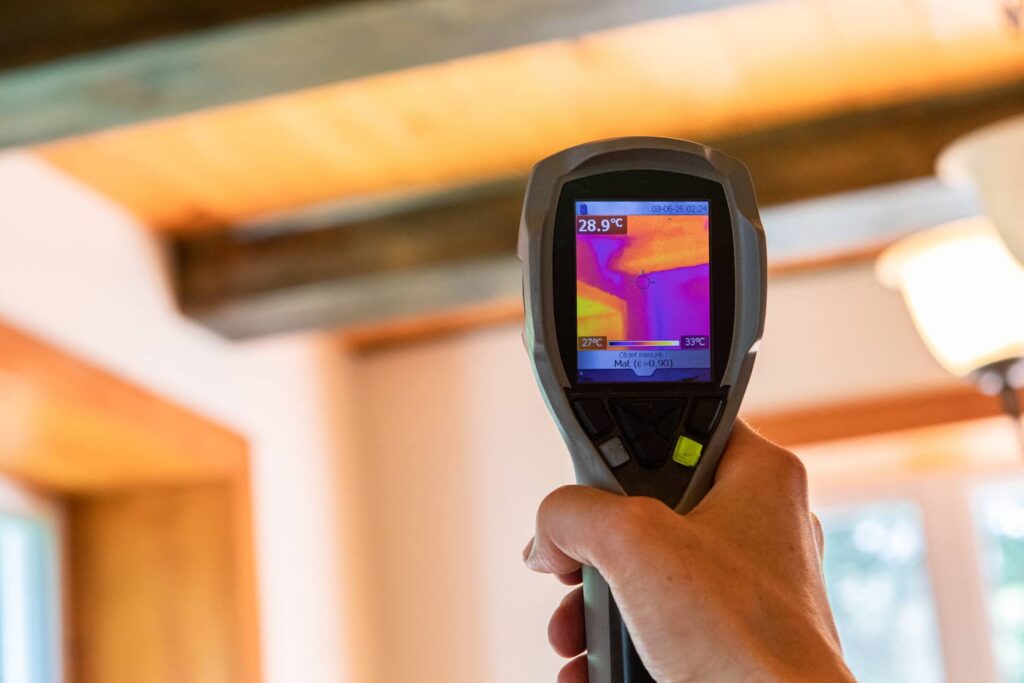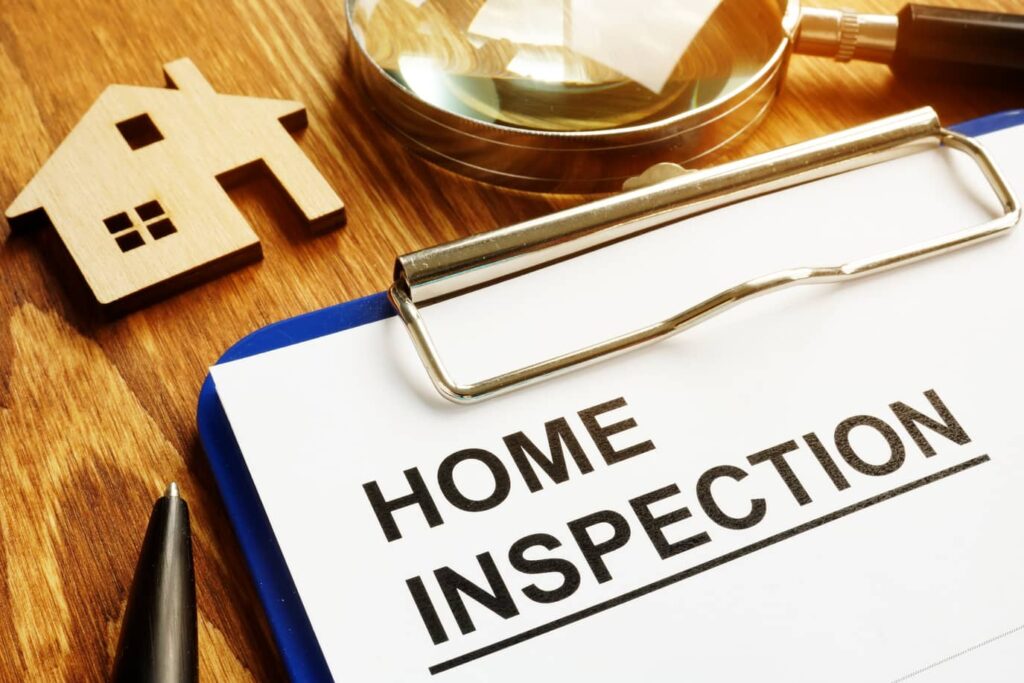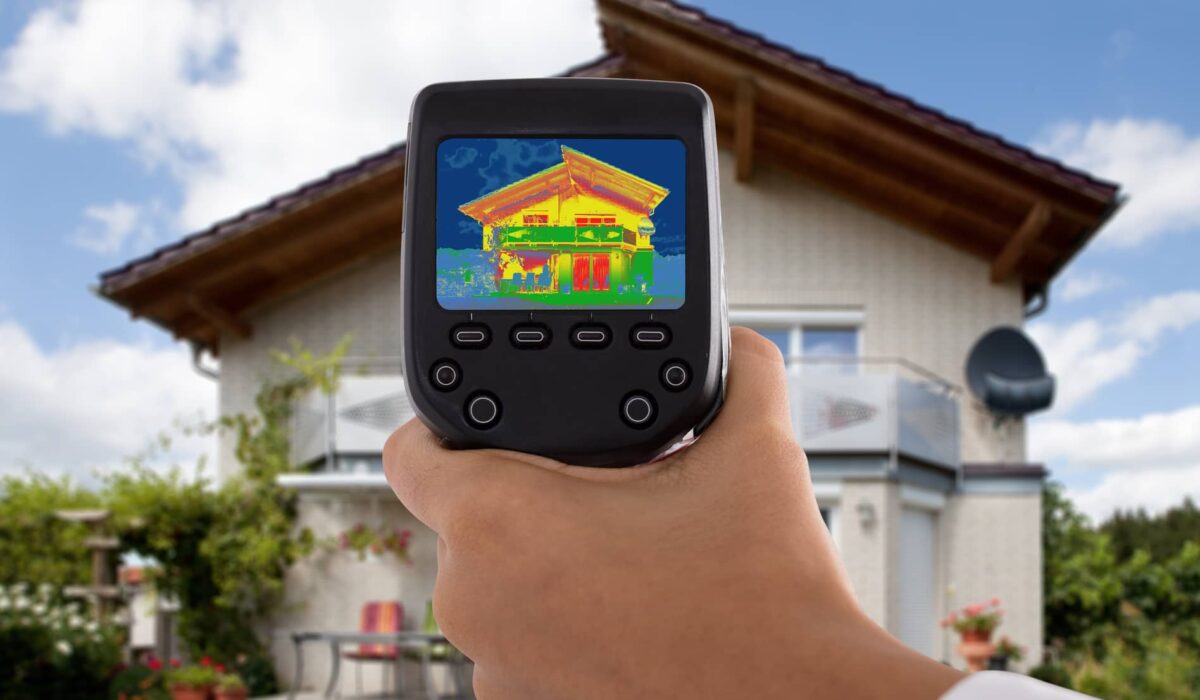Imagine being able to view the world in a completely different light—quite literally. That’s what thermal imaging cameras do. They’re not your everyday point-and-shoot gadgets; they offer us a glimpse into the unseen realm of heat energy—an uncharted territory for our naked eyes. What makes thermal imaging cameras useful? They can show us energy leaks, issues with insulation, damp areas, and electrical issues. These are things that can’t be seen with the naked eye and require a thermal imaging camera.
Let’s learn more!

What is Thermography?
Thermography, or thermal imaging, is the process of capturing and visualizing heat emitted by objects. Every object around us radiates heat, more formally known as infrared radiation. In simple terms, it’s like seeing the temperature!
History of Thermal Imaging Cameras
Originating from the military domain during the Korean War, thermal imaging cameras have evolved dramatically. Initially oversized and quite cumbersome, these cameras have transformed into sleek devices niftily fitting into your toolbox.
What Makes Thermal Imaging Cameras Useful?
Everyone loves a good superhero, and in the world of home maintenance, thermal imaging cameras are just that. Their superpower? Visibility through darkness, smoke, fog—basically, any obstacle.
Simply put, these cameras reveal what’s hiding in plain sight, bringing to light energy leaks, insufficient insulation, dampness, and electrical issues that can’t be detected otherwise. They quite literally shine a new light on what’s happening around your house.
Other Things Thermal Imaging Cameras Can Detect
We know they help let us know what is going on in the home where we can’t see it. Here are some other things that the thermal imaging cameras can do.
- Temperature variations – The camera collects varying degrees of infrared light to measure the temperatures in the room. However, if the heat levels are high enough, infrared light can detect the temperatures. Also, all objects emit infrared radiation and this is how the camera detects the images.
- Color variations – This is achieved by a microbolometer capturing the infrared radiation and assigning pixels to each. Each pixel is then assigned a color that indicates the temperature.
- Detects wave speeds – Heat instead of visible light is used to create images. Infrared waves are detected and the thermal imaging camera can then determine the difference in wave speeds.
- Detects mechanical waves – Matter oscillations cause mechanical waves. These oscillations then detect energy through a medium and medium transmissions cannot go as far as wave transmissions. The thermal imaging camera is great at detecting mechanical waves because they are shown in different forms. The waves are split into transverse, surface, and longitudinal waves.
Uses of Thermal Imaging Cameras
From locating missing insulation areas, and detecting moisture intrusion, to finding electrical faults, thermal imaging cameras are becoming an essential tool for homeowners. It’s like having X-ray vision but for heat!
How Do Thermal Imaging Cameras Work?
Without going down too deep into the rabbit hole of technical jargon, here’s a quick rundown. These hi-tech devices capture differing amounts of infrared energy emitted by objects. This data is then processed and converted into visual images—voila, thermography magic!

What Are the Benefits of Thermal Imaging Cameras?
The core benefit lies in their non-contact, non-invasive approach. They provide an insight into issues without causing any damage—a ‘look but don’t touch’ kind of approach. An additional perk? It helps save some cash by addressing problems before they worsen! Think hard hat, safety glasses, good to go, right? Not quite. Another advantage of thermal imaging cameras is their ability to enhance safety. By helping detect hidden issues like gas leaks or electrical faults, they can keep your family and home safe. They are also a great add-on for new construction home inspections and new-to-you home inspections.
If you have wondered how they work, here is a great video below!
Other Recommended Maintenance
Now that you are aware of what makes thermal imaging cameras useful, you can read up on how to find water leaks inside your walls. In most cases, a thermal imaging camera is used to help detect the changes in temperatures at the location of the water leak.
Next, you can have your HVAC system inspected with a thermal imaging camera. This can tell you if there are any damages to the electrical components that might need repair. Doing this can extend the longevity of your HVAC system and ensure that it lasts up to 17 years or more.
Lastly, this is a great time to read up on the Dos and Don’ts of home inspections for home buyers. Having this knowledge is key to enhancing the power of the buyer over the seller.
Calling in the Professionals: When Is It Time?
While thermal imaging cameras are handy tools for preliminary inspections, it’s crucial not to bite off more than you can chew. Complex issues require professional expertise. If your camera alerts you to significant discrepancies, it’d be wise to call in an expert. Edifice Inspections are trained in using the thermal imaging camera and can help you find out what the issues are in the home.
Conclusion
Finding out where there are issues in the home is important so it can be taken care of right away. Not every home inspection company is trained in using these cameras so you need to reach out to a company that is. Many companies offer it as an ancillary service. It is worth the money to find out the issues in your home so you keep yourself and your family safe. Reach out to Edifice Inspections in Peachtree Corners, GA for a full home inspection with thermal imaging.


6 Comments
Comments are closed.